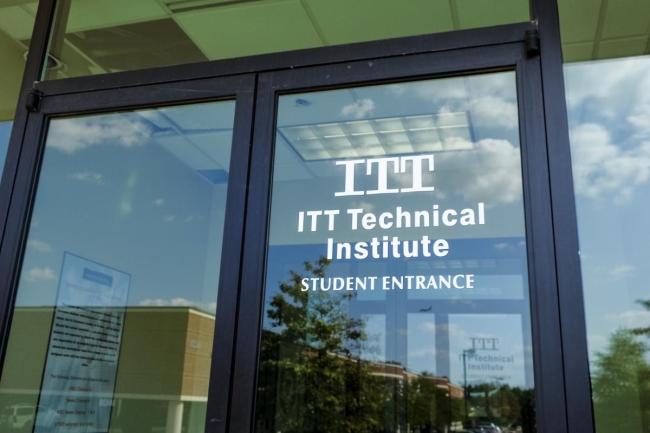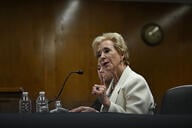You have /5 articles left.
Sign up for a free account or log in.

The number of borrowers affected by college closures, according the GAO report, peaked in 2016, when the for-profit chain ITT Technical Institute closed.
Jahi Chikwendiu/The Washington Post/Getty Images
A preliminary report by the Government Accountability Office suggests that students who attended institutions that were subsequently closed should have their loans automatically discharged in order to help the borrowers who are struggling to repay student loans they took out to pay tuition at the now-closed colleges. The discharges would be in line with an Obama-era policy to which the Department of Education is looking to return.
Over 80,000 borrowers had their loans forgiven from 2010 to 2020 through the closed-college discharge process, which students are eligible for if they’re unable to complete their program of study due to their institution’s closure. The vast majority -- 96 percent -- of the discharges went to students who attended for-profit colleges, according to the report.
Around 58 percent of borrowers have had their loans discharged by submitting an application to the department. That was the only way to receive a closed-college discharge until a regulation put into place by the Obama administration took effect in 2018, automatically granting discharges to borrowers who were enrolled in an institution that closed by November 2013 and who didn’t re-enroll at another college within three years of the institution’s closure. But the Trump administration eliminated the automatic discharge process in July 2020.
Democrats at a House Education and Labor subcommittee hearing Thursday argued the department needs to restore the automatic discharge process to provide relief to students without requiring them to submit information that the department already has available.
“Many students do not become aware that they are entitled to loan relief until after they have already damaged their credit through delinquency and default,” said Representative Frederica Wilson, a Democrat from Florida and chair of the Higher Education and Workforce Investment subcommittee. “It is critical that affected students receive more timely information about the process for applying for closed-school discharge.”
Findings from the GAO’s report show that automatic closed-college discharges tend to help borrowers who are struggling the most with repaying their student loan debt. While only 6 percent of borrowers who applied for a discharge had defaulted on their loans, 52 percent of those receiving automatic forgiveness had defaulted. Additionally, 21 percent of those receiving automatic discharges were past due on their loans by 90 days or more at some point during repayment, but the same was true for only 11 percent of those who applied for forgiveness.
Democrats also said the department should reduce the period of time before automatic discharges occur from three years after an institution’s closure to one year -- more than half of the borrowers who defaulted on their loans before receiving an automatic discharge did so within a year and a half of their college closing, according to the report.
Not providing automatic discharges tends to hurt low-income, Black and Latinx borrowers the most, many of whom are unaware that their student debt is eligible for forgiveness, said Robyn Smith, senior attorney at the Legal Aid Foundation of Los Angeles and a witness at the hearing.
“The department’s failure to provide widespread and automatic closed-school discharges to these borrowers has systematically removed wealth from economically disadvantaged families and communities -- including communities of color -- through the collection of burdensome and invalid debt, often through seizures of wages, tax refunds and federal benefits,” Smith said.
Improving borrower access to closed-college discharges is on the agenda for next week’s first negotiated rule making session, where a committee of negotiators will meet to discuss new Title IV regulations. The department is proposing to both reinstate the automatic closed-college discharges and reduce the waiting period to one year.
Republicans at the hearing were pushing for a different approach to resolve the burdens students face when their institution closes. Representative Greg Murphy, a Republican from North Carolina and ranking member of the subcommittee, said students should instead have the option to continue their program of study at a different college.
“Finishing their programs will be a far greater benefit for students in the long term, really, than just forgiving their loan,” Murphy said. “Simply discharging students’ debt without providing every avenue possible to degree completion leaves taxpayers bearing an unnecessary burden. This is simply not a reasonable pathway.”
Murphy referenced the Biden administration’s recent decision to provide closed-school discharges to 115,000 borrowers who attended the now-defunct ITT Technical Institute up to eight years before it closed, adding, “This will cost taxpayers over $1 billion.”
But Smith noted in her testimony that most borrowers who attended closed for-profit institutions are unable to transfer their credits to a public college, and even if their credits transfer, they may not apply to their degree requirements. Additionally, unpaid federal loans make it difficult for students to start over elsewhere, especially if their loans are in default, they’re close to the federal borrowing limit or they’ve used up their lifetime Pell Grant allotment, said Smith.
Preston Cooper, a research fellow at the Foundation for Research on Equal Opportunity and a hearing witness, suggested that Congress require institutions dependent on federal student aid to purchase insurance to reimburse taxpayers for a closed-college discharge. Cooper testified that the policy would provide a financial incentive for institutions to avoid discharges, such as by improving the transferability of their credits.
“Closed-school discharges should be the last option to consider -- not the first,” Cooper said. “The challenge is not preventing school closures but managing them to ensure students can complete their education elsewhere and do not impose excessive burdens on taxpayers through the closed-school discharge process.”
During his closing remarks, Murphy encouraged his colleagues to consider Cooper’s proposed policy, noting that he believes the committee could find bipartisan support for it.
“The policies we’re talking about today, the ones which the Biden administration seeks to expand, place the entire burden of the students’ debt on hardworking taxpayers,” he said. “Let us work together on a proactive way of dealing with this rather than just dumping things, oftentimes, on taxpayers, most of which have no skin in this game.”




